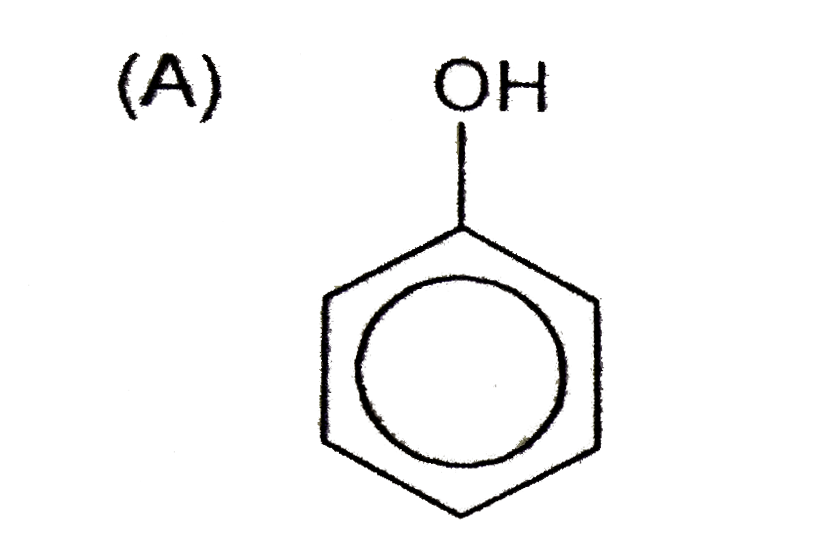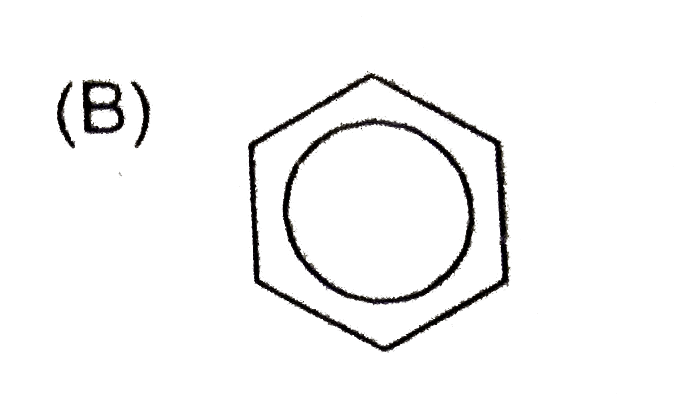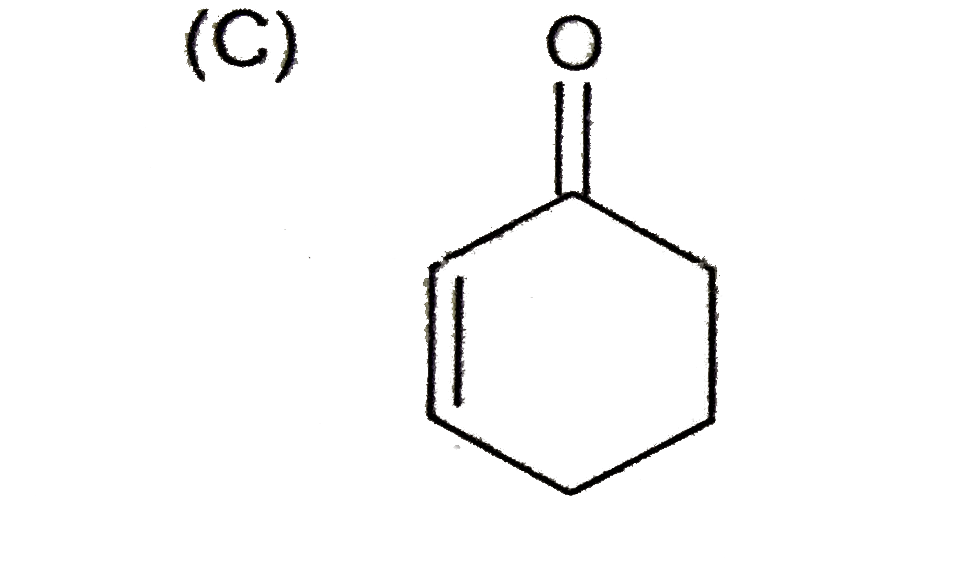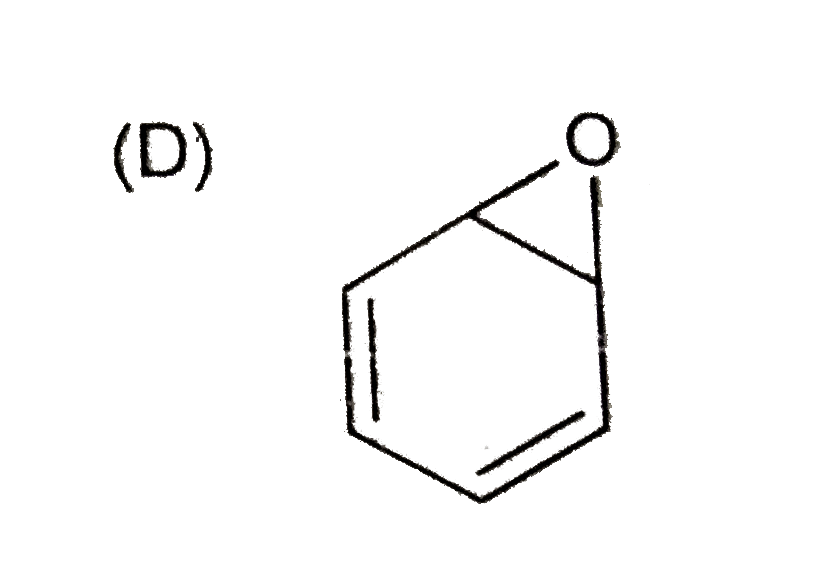Iso-propyl alcohol Al2O3−−−→ΔBConc−−−→H2SO4Cwater−−→boilD. In this reaction D is:
Iso - propyl alcohol
Propene
n - butyl alcohol
n - propyl alcohol
The correct Answer is:A
To solve the problem step by step, we will analyze the reactions involving isopropyl alcohol (C3H8O) and identify the product D formed after the series of reactions.
Step 1: Identify the starting compound
The starting compound is isopropyl alcohol, which is also known as 2-propanol. Its structure can be represented as:
CH3CHOHCH3
Step 2: Reaction with Al2O3 and heat
When isopropyl alcohol is heated in the presence of aluminum oxide (Al2O3), it undergoes dehydration. This means that a water molecule (H2O) is removed from the alcohol. The reaction can be represented as:
CH3CHOHCH3Δ,Al2O3−−−−−→C3H6+H2O
This results in the formation of propene (C3H6), which is an alkene.
Step 3: Reaction with concentrated H2SO4
Next, the propene formed reacts with concentrated sulfuric acid (H2SO4). According to Markovnikov's rule, the addition of H2SO4 to the alkene will lead to the formation of an alkyl hydrogen sulfate. The hydrogen from H2SO4 will add to the carbon with more hydrogen atoms, and the bisulfate ion (HSO4-) will add to the other carbon. The reaction can be represented as:
C3H6+H2SO4→C3H7OSO3H
This product is isopropyl hydrogen sulfate.
Step 4: Hydrolysis with water
When the isopropyl hydrogen sulfate is treated with water (boiling), hydrolysis occurs, resulting in the formation of isopropyl alcohol. The reaction can be represented as:
C3H7OSO3H+H2O→C3H8O+H2SO4
Thus, the final product D is isopropyl alcohol (C3H8O).
Conclusion
The final product D is isopropyl alcohol, also known as 2-propanol.
Answer
D is isopropyl alcohol (2-propanol).
---
The starting compound is isopropyl alcohol, which is also known as 2-propanol. Its structure can be represented as:
CH3CHOHCH3
When isopropyl alcohol is heated in the presence of aluminum oxide (Al2O3), it undergoes dehydration. This means that a water molecule (H2O) is removed from the alcohol. The reaction can be represented as:
CH3CHOHCH3Δ,Al2O3−−−−−→C3H6+H2O
This results in the formation of propene (C3H6), which is an alkene.
Next, the propene formed reacts with concentrated sulfuric acid (H2SO4). According to Markovnikov's rule, the addition of H2SO4 to the alkene will lead to the formation of an alkyl hydrogen sulfate. The hydrogen from H2SO4 will add to the carbon with more hydrogen atoms, and the bisulfate ion (HSO4-) will add to the other carbon. The reaction can be represented as:
C3H6+H2SO4→C3H7OSO3H
This product is isopropyl hydrogen sulfate.
When the isopropyl hydrogen sulfate is treated with water (boiling), hydrolysis occurs, resulting in the formation of isopropyl alcohol. The reaction can be represented as:
C3H7OSO3H+H2O→C3H8O+H2SO4
Thus, the final product D is isopropyl alcohol (C3H8O).
The final product D is isopropyl alcohol, also known as 2-propanol.
D is isopropyl alcohol (2-propanol).
Topper's Solved these Questions
- BOOK - PHYSICS WALLAHCHAPTER - ALCOHOLS, PHENOLS AND ETHERS EXERCISE - NEET PAST 5 YEARS QUESTIONS28videos
ALCOHOLS, PHENOLS AND ETHERS
- BOOK - PHYSICS WALLAHCHAPTER - ALCOHOLS, PHENOLS AND ETHERS EXERCISE - NEET PAST 5 YEARS QUESTIONS28videos
ALCOHOLS, PHENOLS AND ETHERS
- BOOK - PHYSICS WALLAHCHAPTER - ALDEHYDES, KETONES AND CARBOXYLIC ACID EXERCISE - NEET PAST 5 YEARS QUESTIONS16videos
ALDEHYDES, KETONES AND CARBOXYLIC ACID
Similar Questions
Knowledge Check
- Question 1 - Select One
Iso-propyl alcohol Al2O3−−−→ΔBConc−−−→H2SO4Cwater−−→boilD. In this reaction D is:
AIso - propyl alcoholBPropeneCn - butyl alcoholDn - propyl alcohol - Question 2 - Select One
Iso-propyl alcohol Al2O3−−−→ΔBConc−−−→H2SO4Cwater−−→boilD. In this reaction D is:
AIso - propyl alcoholBPropeneCn - butyl alcoholDn - propyl alcohol - Question 3 - Select One
 Conc.−−−−−−→H2SO4/Δ identify product?A
Conc.−−−−−−→H2SO4/Δ identify product?A B
B C
C D
D
In the reaction sepuence, CaC2H2O−−→Adil.H2SO4−−−−−−→Hg2+BH2−−→NiC, the product Cis
View SolutionPhenol Zn-dust−−−→AConc.HNO3−−−−−−−→+H2SO4BZn−−−→NaOHC
In the above reaction A, B and C are :View Solution2Ph−O∣∣C−CH3Mg−Hg−−−−→H2OConc.H2SO4−−−−−−−→ΔKMnO4H⊕−−−−−−−→
The final product isView SolutionCH3CH2BrAq.KOH−−−−−→ΔAKMnO4/H+−−−−−−−−→ΔBNH3−−→ΔCBr2−−→AlkaliD, D is
View SolutionACu←−−ΔCH3CH2OHAl2O3−−−→ΔB.
A and B respectively are :View Solution


_E01_782_Q01.png)
 underset (Conc. H_(2)SO_(4))overset(Conc. HNO_(3))toP underset(Delta)overset(Sn, Conc. HCl)toQ
underset (Conc. H_(2)SO_(4))overset(Conc. HNO_(3))toP underset(Delta)overset(Sn, Conc. HCl)toQ